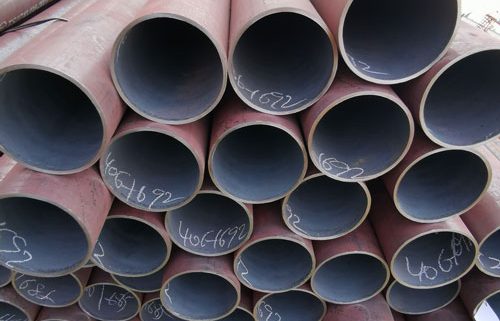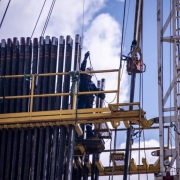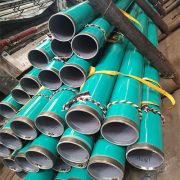라인 파이프의 정의
석유, 가스, 물과 같은 유체를 장거리로 운송해야 하는 산업에서 배관 시스템을 선택하는 것은 안전성, 효율성, 비용 효율성을 보장하는 데 매우 중요합니다. 이러한 분야에서 가장 일반적으로 사용되는 구성 요소 중 하나는 다음과 같습니다. 라인 파이프. 이 블로그 게시물은 라인 파이프가 무엇인지, 주요 특징, 응용 분야, 석유, 가스, 물의 전송 분야에서 일하는 전문가를 위한 고려 사항에 대해 자세히 살펴봅니다.
라인파이프란?
라인 파이프는 액체, 가스, 때로는 고체를 운반하기 위해 특별히 설계된 강관의 한 종류입니다. 일반적으로 탄소강이나 합금강으로 제조되는 라인 파이프는 고압, 부식 및 극한의 온도를 견디도록 설계되어 유체를 광대한 거리를 운반해야 하는 석유 및 가스와 같은 산업에 이상적입니다.
라인 파이프는 석유, 천연 가스, 물 및 기타 유체를 생산 시설에서 정유소, 가공 공장 또는 유통망으로 옮기는 파이프라인에서 중요한 역할을 합니다. 에너지 인프라의 중추 역할을 하여 원자재가 효율적이고 안전하게 전달되도록 합니다.
라인 파이프의 주요 특징
라인 파이프는 엄격한 표준을 충족하도록 제조되며 특정 전송 시스템의 요구 사항에 맞게 다양한 등급, 치수 및 재료로 제공됩니다. 다음은 라인 파이프를 유체 수송에 필수적인 구성 요소로 만드는 몇 가지 중요한 기능입니다.
1. 재료 강도 및 내구성
라인 파이프는 주로 탄소강으로 만들어지지만, 스테인리스강 및 고강도 저합금강과 같은 다른 합금도 응용 분야에 따라 사용될 수 있습니다. 이러한 재료는 우수한 인장 강도를 제공하여 파이프가 높은 내부 압력과 설치 및 작동의 기계적 응력을 견딜 수 있습니다.
2. 부식 저항
부식은 파이프라인, 특히 장거리에 걸쳐 석유, 가스 또는 물을 운송하는 파이프라인에서 심각한 문제입니다. 라인 파이프는 종종 아연 도금, 에폭시 코팅 또는 음극 보호 시스템과 같은 다양한 코팅 및 처리 공정을 거쳐 부식을 방지하고 작동 수명을 연장합니다.
3. 높은 압력 및 온도 허용 범위
라인 파이프는 고압 조건에서 작동하도록 설계되었습니다. 운반되는 유체와 환경 조건에 따라 파이프는 상당한 온도 변동을 견뎌야 합니다. API 5L과 같은 파이프라인 등급은 다양한 압력과 온도에 대한 성능 표준을 지정합니다.
4. 용접성
파이프라인은 일반적으로 섹션으로 구성되고 용접되므로 라인 파이프는 우수한 용접성 특성을 가져야 합니다. 용접성은 파이프 섹션 간의 안전하고 누출 방지 연결을 보장하여 파이프라인의 전반적인 무결성에 기여합니다.
라인 파이프의 종류
라인 파이프는 여러 유형으로 나뉘며 각각 특정 요구 사항에 맞게 조정됩니다. 다음은 석유, 가스 및 물 전송에 사용되는 두 가지 주요 유형입니다.
1. 이음매 없는 라인 파이프
이음매 없는 라인 파이프는 이음매 없이 제조되므로 고압 응용 분야에 이상적입니다. 솔리드 스틸을 튜브 형태로 압연하여 생산한 다음 원하는 두께와 직경으로 압출합니다. 이음매 없는 라인 파이프는 더 높은 강도와 부식 및 응력 균열에 대한 더 나은 저항성을 제공합니다.
2. 용접 라인 파이프
용접 라인 파이프는 평평한 강철을 원통 모양으로 성형하고 가장자리를 용접하여 만듭니다. 용접 파이프는 대구경으로 생산할 수 있으므로 저압에서 중압 응용 분야에 더 비용 효율적입니다. 그러나 용접 파이프는 이음매에서 응력을 받기 쉽기 때문에 작동 압력이 낮은 곳에서 자주 사용됩니다.
라인 파이프의 일반적인 응용 분야
라인 파이프는 다음을 포함한 다양한 산업에서 사용됩니다.
1. 오일 전송
석유 산업에서 라인 파이프는 원유를 추출 현장에서 정유소로 운송하는 데 사용됩니다. 파이프는 고압, 부식성 물질 및 연마 조건을 견뎌야 하며, 장거리에서 안전하고 지속적인 운송을 보장해야 합니다.
2. 천연가스 전송
천연가스 파이프라인은 높은 압력을 처리할 수 있고 변동하는 환경 조건에서 누출 방지 기능을 유지할 수 있는 라인 파이프가 필요합니다. 천연가스 응용 분야의 라인 파이프는 특히 추운 기후에서 인성과 취성 파괴 저항성에 대한 추가 테스트를 거칩니다.
3. 물 분배
라인 파이프는 식수, 폐수 및 산업용수의 분배에 광범위하게 사용됩니다. 물 전달에서 내식성은 주요 관심사이며, 시멘트 모르타르 또는 폴리에틸렌과 같은 코팅이나 라이닝은 종종 강철을 보호하고 파이프의 수명을 연장하기 위해 적용됩니다.
4. 화학 전달
화학 산업의 파이프라인은 다양한 액체와 가스를 운반하는데, 그 중 일부는 부식성이 있거나 위험할 수 있습니다. 이러한 응용 분야에서 사용되는 라인 파이프는 환경적 피해나 안전 위험으로 이어질 수 있는 누출이나 고장이 없는지 확인하기 위해 엄격한 안전 표준을 충족해야 합니다.
라인 파이프의 주요 표준
석유, 가스 및 물 전송 산업에서 사용되는 라인 파이프는 다양한 국제 표준을 따르며, 이를 통해 파이프가 필요한 안전, 성능 및 품질 요구 사항을 충족하는지 확인합니다. 가장 널리 인정되는 표준 중 일부는 다음과 같습니다.
- API 5L(미국석유협회): 이는 석유 및 가스 전송에 사용되는 라인 파이프에 대한 가장 일반적으로 참조되는 표준입니다. API 5L은 파이프 재료, 기계적 특성 및 테스트 방법에 대한 요구 사항을 정의합니다.
- ISO 3183(국제 표준화 기구): 이 표준은 석유 및 천연가스 산업의 파이프라인 운송 시스템을 위한 강철 라인 파이프에 대한 사양을 다룹니다. ISO 3183은 라인 파이프가 글로벌 모범 사례에 따라 제조되도록 보장합니다.
- ASME B31.8(미국기계학회): 이 표준은 가스 전송 및 분배 파이프 시스템에 초점을 맞춥니다. 파이프라인의 설계, 재료, 건설, 테스트 및 운영에 대한 지침을 제공합니다.
- EN 10208-2(유럽 표준): 이 표준은 유럽 국가에서 가연성 액체 또는 가스의 전송에 사용되는 강관에 적용됩니다. 재료, 치수 및 테스트에 대한 성능 벤치마크를 설정합니다.
공통표준 및 강종
| PSL1 라인 파이프 기계적 특성 | |||
| 등급 | 항복강도 Rt0,5 Mpa(psi) | 인장강도 Rm Mpa(psi) | 신장 50mm 또는 2in |
| A25/A25P | ≥175(25400) | ≥310(45000) | 아프 |
| ㅏ | ≥210(30500) | ≥335(48600) | 아프 |
| 비 | ≥245(35500) | ≥415(60200) | 아프 |
| X42 | ≥290(42100) | ≥415(60200) | 아프 |
| X46 | ≥320(46400) | ≥435(63100) | 아프 |
| X52 | ≥360(52200) | ≥460(66700) | 아프 |
| X56 | ≥390(56600) | ≥490(71100) | 아프 |
| X60 | ≥415(60200) | ≥520(75400) | 아프 |
| X65 | ≥450(65300) | ≥535(77600) | 아프 |
| X70 | ≥485(70300) | ≥570(82700) | 아프 |
| PSL2 라인 파이프 기계적 특성 | ||||
| 등급 | 항복강도 Rt0,5 Mpa(psi) | 인장강도 Rm Mpa(psi) | Rt0,5/Rm | 신장 50mm 또는 2in |
| BR/BN/BQ | 245(35500)-450(65300) | 415(60200)-655(95000) | ≤0.93 | 아프 |
| X42R/X42N/X42Q | 290(42100)-495(71800) | ≥415(60200) | ≤0.93 | 아프 |
| X46N/X46Q | 320(46400)-525(76100) | 435(63100)-655(95000) | ≤0.93 | 아프 |
| X52N/X52Q | 360(52200)-530(76900) | 460(66700)-760(110200) | ≤0.93 | 아프 |
| X56N/X56Q | 390(56600)-545(79000) | 490(71100)-760(110200) | ≤0.93 | 아프 |
| X60N/X60Q | 415(60200)-565(81900) | 520(75400)-760(110200) | ≤0.93 | 아프 |
| X65Q | 450(65300)-600(87000) | 535(77600)-760(110200) | ≤0.93 | 아프 |
| X70Q | 485(70300)-635(92100) | 570(82700)-760(110200) | ≤0.93 | 아프 |
라인 파이프 선택을 위한 실제 고려 사항
석유, 가스 또는 물 전송을 위한 라인 파이프를 선택할 때 최적의 성능과 안전을 보장하기 위해 여러 요소를 고려하는 것이 필수적입니다. 다음은 몇 가지 주요 고려 사항입니다.
1. 작동 압력 및 온도
파이프 재료와 벽 두께는 유체의 예상 작동 압력과 온도를 처리하도록 선택해야 합니다. 과도한 압력은 파이프라인 고장으로 이어질 수 있으며, 고온에 대한 내성이 부족하면 약화되거나 변형될 수 있습니다.
2. 유체의 부식성
원유나 특정 화학 물질과 같은 부식성 유체에는 특수 코팅이나 재료가 필요할 수 있습니다. 적절한 내식성을 갖춘 파이프를 선택하면 파이프라인의 서비스 수명을 크게 연장할 수 있습니다.
3. 거리 및 지형
파이프라인의 길이와 위치는 필요한 라인 파이프 유형에 영향을 미칩니다. 예를 들어, 산악 지역이나 극한 기온 지역을 가로지르는 파이프라인은 응력과 환경 조건을 처리하기 위해 더 내구성이 뛰어나고 두꺼운 파이프가 필요할 수 있습니다.
4. 규제 및 안전 준수
지역, 국가 및 국제 규정을 준수하는 것이 중요합니다. 라인 파이프가 사용될 지역 및 산업에 필요한 표준을 충족하는지 확인하십시오. 이는 파이프라인 고장이 심각한 환경 및 안전 결과를 초래할 수 있는 석유 및 가스와 같은 위험한 산업에서 특히 중요합니다.
결론
라인 파이프는 석유, 가스 및 물 수송 산업에서 중요한 구성 요소입니다. 강도, 내구성 및 극한 조건을 견뎌낼 수 있는 능력으로 인해 장거리에 걸쳐 유체를 운반하는 데 없어서는 안 될 요소입니다. 다양한 유형의 라인 파이프, 해당 용도 및 선택을 위한 주요 고려 사항을 이해함으로써 이 분야의 전문가는 파이프라인의 안전하고 효율적인 운영을 보장할 수 있습니다.
석유 추출, 천연가스 분배 또는 수자원 인프라에서 작업하든 올바른 라인 파이프를 선택하는 것은 전송 시스템의 무결성을 유지하는 데 필수적입니다. 파이프라인 성능을 최적화하고 비용이 많이 드는 고장을 방지하기 위해 항상 품질, 안전 및 산업 표준 준수를 우선시하십시오.








